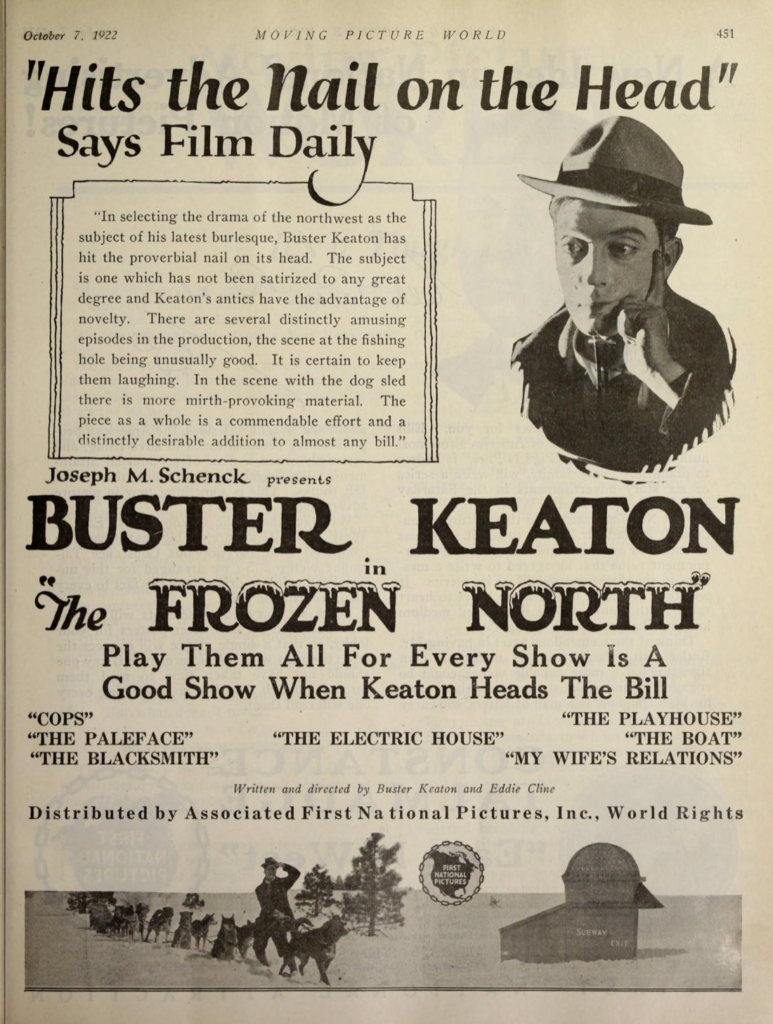
"No man can be a genius in slapshoes and a flat hat." -Buster Keaton -

"No man can be a genius in slapshoes and a flat hat." -Buster Keaton -
Released in 1922, The Frozen North is a 17-minute American short comedy film. Buster Keaton both directed and starred in the parody of early Western films, specifically mocking the style of acclaimed actor William S. Hart. Keaton co-wrote the script with Edward F. Cline. Sybil Seely and Bonnie Hill appear as Keaton’s co-stars.

The Frozen North was made by Keaton shortly after his friend Roscoe “Fatty” Arbuckle was arrested and charged with assaulting Virginia Rappe. While most of Hollywood refused to publicly support Arbuckle per studio bosses’ orders, Keaton did make a statement proclaiming his innocence. However, actor William S. Hart presumed Arbuckle’s guilt and made damaging public remarks despite not knowing him. Arbuckle later wrote a film premise mocking Hart’s bullying persona, which Keaton acquired and turned into The Frozen North. It was well known that Hart had aggressive tendencies, and Keaton felt he was influencing the accusations against Arbuckle.
An interesting side note is that The Frozen North and the Ruth Roland serial production The Timber Queen filmed neighboring one other in Truckee, California in early 1922. A behind-the-scenes photo shows Keaton and Roland sitting on a sled together outfitted in fur coats.

The Frozen North also marked the final acting role of Sybil Seely, Keaton’s co-star.
In the parody film, Keaton wears a tiny version of Hart’s campaign hat and twin holstered six-shooters. He mimics Hart’s trademark glycerin tears in an emotional scene of shooting a neighbor and her husband.

Overall, he exaggerates Hart’s stiff style with excessive standing and staring. Audiences of the 1920s recognized and delighted in the caricature of Hart. However, Hart himself took offense, especially to the crying bit, and refused to speak to Keaton for two years after seeing it. The comedy also briefly kids the womanizing character of Erich von Stroheim’s Foolish Wives film, which von Stroheim sportingly approved of.


The Frozen North was filmed midwinter on location at Donner Lake just outside Truckee, California. Its mock-serious opening titles quoting Robert Service’s poem “The Shooting of Dan McGrew” set the tone. Many funny gags from the film later turned up in various Three Stooges shorts. And its dream sequence plot device predated Keaton’s own use of that premise in his feature Sherlock Jr.
Watch the full move by hitting the play button below.
The film opens in a remote Alaskan subway station emerging from the snow. A tough cowboy type (Buster Keaton) arrives and makes his way to a nearby settlement. There, he tries to rob some men playing poker by using a cardboard cutout of a gunman at the window to scare them. When the men catch on to the trick, they toss Keaton out.

He then mistakenly enters a house, thinking it’s his own. Inside he sees a couple kissing by the fireplace. Assumed it’s his wife, a distraught Keaton shoots them before realizing his error and slipping away. At his actual house, his wife greets him but he coldly brushes her off. Hurt, she cries out and is knocked unconscious by a falling vase. A passing policeman hears the racket but Keaton diverts him by dancing with his wife’s limp body.
Keaton spots his pretty neighbor lady. He puts on a nice suit, picks some mysteriously growing flowers, and tries wooing her, but she seems uninterested. Her husband angrily drags her away when he finds Keaton inside. The couple moves even further north, but Keaton pursues in a makeshift dog sled car. After various mishaps and adventures, he finds their igloo and tries fishing through the ice, unsuccessfully.

Fortified by a bottle of “strong liquor” cola, he makes another pass at the neighbor lady despite her protests. Hearing the husband returning, Keaton attempts hiding in various silly ways. There’s a symbolic scene implying Keaton’s villainous intent to force himself on the woman against her will. But then the husband appears and fights Keaton. Just as Keaton pulls a gun, the scene cuts to him waking up from his dreamed adventure to a movie theater janitor telling him the show is over.
